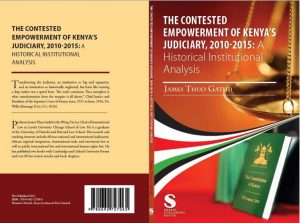
LATEST BOOK:
The Contested Empowerment of Kenya’s Judiciary 2010 -2015
Authored by Prof. James T. Gathii
Click HERE to see the Table of Contents
 This book assesses the empowerment of the Kenyan Judiciary and the backlash from Parliament and the Executive that followed. Why did Kenyans and the politicians who acquiesced to the 2010 Constitution, want constitutional constraint by courts? Did politicians regard a strong judiciary as an ally or as a future constraint on their freedom of action? In the past, politicians routinely subordinated the judiciary to their whims. Did they not anticipate that an empowered judiciary would assert its authority in politically salient cases? Scholars use three theoretical frameworks to account for the rise of judicial empowerment: Rational strategic, attitudinalist and historical institutionalist accounts.
This book assesses the empowerment of the Kenyan Judiciary and the backlash from Parliament and the Executive that followed. Why did Kenyans and the politicians who acquiesced to the 2010 Constitution, want constitutional constraint by courts? Did politicians regard a strong judiciary as an ally or as a future constraint on their freedom of action? In the past, politicians routinely subordinated the judiciary to their whims. Did they not anticipate that an empowered judiciary would assert its authority in politically salient cases? Scholars use three theoretical frameworks to account for the rise of judicial empowerment: Rational strategic, attitudinalist and historical institutionalist accounts.
This book argues that historical institutionalism offers the best explanation. Although judicial transformation was always a central agenda in the twenty years of start-stop constitution making prior to 2010, it was held in abeyance until the political order that had previously controlled the constitution making process was disrupted by post election violence in 2008. That violence provided a historical turning point that catalyzed the 2010 Constitution.
The appointment of a Chief Justice and a new cohort of highly qualified judges, changes in the recruitment, discipline and removal of judges, increased budgetary allocations to the judiciary and an active civil society movement helped to build an empowered judiciary – a judiciary that declared the supremacy of the Constitution over all organs of government including the Executive and Parliament. Politicians have not easily acquiesced to or welcomed this new judicial review of their conduct.
In the final analysis, this book finds that although the newly empowered judiciary has significantly reshaped constitutional and legal doctrine in a number of areas and become an independent arm of the government, transforming it has involved many complex challenges and risks that require firm resolve, leadership and committed constituencies as well as resources. Judicial reform is after all, a legal as well as a political process that faces opportunities challenges and even possible reversal.

